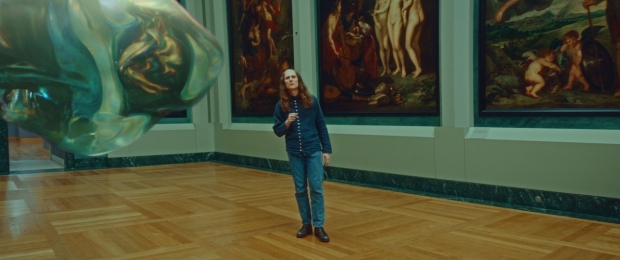Created by Paul Trillo, the short follows a cosmic teardrop throughout the Musée Du Louvre; behind-the-scenes short illustrates how traditional VFX and AI tools help realize creative visions.
Director Paul Trillo’s new music video, Absolve, takes viewers inside French music artist Jacques' mental vortex as he follows a cosmic teardrop throughout the Musée Du Louvre. As a director who embraces experimentation and tech innovation, Trillo pushed the boundaries of digital tools including the employ of alternatives to traditional post-production approaches.
In the short, classical artworks are experienced in an entirely new light through a series of experimental visual sequences. The Musée Du Louvre is the perfect backdrop to illustrate the concept, symbolizing art in a cosmopolitan sense. Trillo employs a tongue-in-cheek approach to using AI to transform classical artwork and place it in the context of art history. For the director, AI is more than just a technical tool; it is a part of an experimental creative process, sometimes producing unexpected results that lead to new creative paths.
By fusing traditional VFX with various AI techniques, Trillo offers an alternative approach to visual effects, taking a step toward making generative AI eventually appear invisible. The director used traditional a VFX workflow and CG enhancements with tools like After Effects and Houdini throughout the production. However, most of the film's 80 visual effects shots used an array of AI tools, including Stable Diffusion, Runway, and Luma.
Trillo shared his production process, noting that Stable Diffusion did much of the heavy lifting to create the look of the teardrop bubble, the “horrifically” transformed artwork, and the face aging makeup seen at the end. In some cases, Runway's Gen-2 created elements like the bubble instead of relying on 3D animation. It was then filtered through Stable Diffusion to achieve its unique texture and aesthetic, which, according to Trillo, is not possible with a 3D workflow. Runway was used for rotoscoping, frame interpolation, and slow motion. Luma Labs was employed to capture 3D NeRF scans of Jacques and the environments in the Louvre. All these elements were further affected, filtered, and composited in After Effects to create a look that didn't feel purely AI-driven. Finally, the entire film was transferred to 16mm film stock to give it a more tangible feel.
According to Trillo, the film demonstrates new techniques and aesthetics that have emerged, offering a path to independent creators on how they can harness these technologies to achieve ambitious ideas otherwise thought of as not doable. It further offers skilled artists with a grasp of traditional tools a glimpse of how new generative tools can elevate their work, possibly opening the door to entirely new kinds of creations.
Technology also offers a potentially cost-efficient way for independent artists to work in certain genres or time periods, otherwise unattainable. AI techniques also open animation to the telling of more mature, adult-themed animated features – a genre dominated mainly by family films in the U.S.
Trillo tempers his optimistic view of the future of technology with the reminder that “There is plenty to be cautious of, and we can’t lose sight of ethics, but denying the progress of new visual techniques goes against what the field has always stood for.”
Watch: Jacques - “Absolve” and then watch the VFX breakdown to see its creation:
Watch: “Absolve” VFX Breakdown:
Dan Sarto is Publisher and Editor-in-Chief of Animation World Network.











